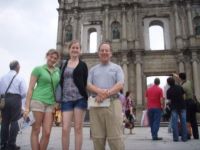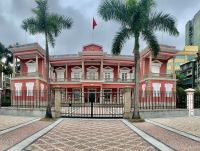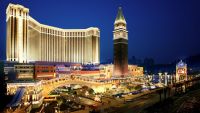I have been to Macau almost every time I’ve been to Hong Kong; indeed, I’ve stayed overnight a few times in the former Portuguese possession. I liked the Mediterranean feel so much, in fact, that it was one of the reasons I had to go to Portugal, which I did last summer. What would it be like to return to Macau having been to Portugal, I wondered?
I had the chance to find out Sunday, and took two students with me on the hour-and-a-half ferry ride across the Pearl River Delta.
There were really excellent museums in Lisbon dealing with Portugal’s once extensive overseas empire, including one on what the Portuguese still consider their special relationship with the Far East. Vasco da Gama is a national hero for having reached India, while Columbus, a Portuguese who sailed for Spain, is barely mentioned. That small country on the fringe of Europe crept down the coast of Africa, reaching India in the early 1600s, acquiring a trading post at Goa that remained a part of Portugal until India seized it in the 1970s (I learned that one of the colonial buildings in Macau,  the “Moorish barracks” housed an Indian regiment—from Goa). In 1513, the Portuguese cajoled the Chinese into permitting a shipwrecked crew to dry its goods at Macau, and the Portuguese stayed until 1999. Until Hong Kong supplanted it as the main entrepot in the China trade, after the first Opium War, Macau played the premier role for foreigners. All trade with China was through Canton, but the traders were not allowed to stay all year in Canton, so they lived in Macau. Their families could not reside in Canton, either, so they lived in Macau. The Protestant cemetery houses tombstones that list the vicissitudes of life on the China coast—died of malaria or typhus, in childbirth, at sea, storming the forts of the Boca Tigris (Canton), etc.
the “Moorish barracks” housed an Indian regiment—from Goa). In 1513, the Portuguese cajoled the Chinese into permitting a shipwrecked crew to dry its goods at Macau, and the Portuguese stayed until 1999. Until Hong Kong supplanted it as the main entrepot in the China trade, after the first Opium War, Macau played the premier role for foreigners. All trade with China was through Canton, but the traders were not allowed to stay all year in Canton, so they lived in Macau. Their families could not reside in Canton, either, so they lived in Macau. The Protestant cemetery houses tombstones that list the vicissitudes of life on the China coast—died of malaria or typhus, in childbirth, at sea, storming the forts of the Boca Tigris (Canton), etc.
Although the city declined in importance after Britain acquired Hong Kong, it remained part of the Portuguese empire, and parts of it grew to resemble Lisbon. The pastel=colored colonial buildings, especially the governor’s  palace (the pink and white exterior resembles one of the imperial palaces in the mother country), seem more Mediterranean than South China Sea. The Portuguese officer’s club would not be out of place in Lisbon, and is one of the more elegant places to eat in town. The McDonald’s, housed in a yellow building, may have the finest setting in the world for the Oakbrook-based company. The food remains—I had African Chicken, the students who came with me had Portuguese rice, and we all had a Portuguese egg tart (just like in Portugal). There are also some blue tile/murals, just like in the mother country. The city has a number of elegant Catholic churches, and the treasuries have the monstrances and other artifacts of Catholic churches, just like the Museum of the Orient in Lisbon. A huge fort remembers the presence of the Dutch, whose repulse in 1622 on St. John’s day gave the city its patron saint. And Portugal’s Homer, Luis Camoes, lived in Macau for a time, and there’s a park named for him (of course, I was the only one on our tour in Portugal who had ever heard of him, but it was nice to make the connection).
palace (the pink and white exterior resembles one of the imperial palaces in the mother country), seem more Mediterranean than South China Sea. The Portuguese officer’s club would not be out of place in Lisbon, and is one of the more elegant places to eat in town. The McDonald’s, housed in a yellow building, may have the finest setting in the world for the Oakbrook-based company. The food remains—I had African Chicken, the students who came with me had Portuguese rice, and we all had a Portuguese egg tart (just like in Portugal). There are also some blue tile/murals, just like in the mother country. The city has a number of elegant Catholic churches, and the treasuries have the monstrances and other artifacts of Catholic churches, just like the Museum of the Orient in Lisbon. A huge fort remembers the presence of the Dutch, whose repulse in 1622 on St. John’s day gave the city its patron saint. And Portugal’s Homer, Luis Camoes, lived in Macau for a time, and there’s a park named for him (of course, I was the only one on our tour in Portugal who had ever heard of him, but it was nice to make the connection).

In 1999, Portugal returned Macau to China, as a special administrative region for 50 years. Thus, although the order of the signage is now reversed (Chinese then Portuguese), Portuguese is still an official language (though not widely spoken). While I came for the old (and the mystery), as a neutral in World War II, Portuguese Macau provided a place of refuge–almost 500,000 Chinese fled here, slightly less than today’s population, (and spies abounded as well), but today most tourists flock to Macau to gamble. Hong Kong has race tracks (some of the students talked about going to a race), Macau has the casinos. Pre-1999, Stanley Ho (he of four wives) had the monopoly; today, it resembles Las Vegas, with a Sands, Wynn, etc., built mostly on reclaimed land in the last ten years.
When we got to immigration, I was pleased because there was a line for senior citizens, while the tour groups clogged the others. The students took almost an hour to get through, that’s how many (mostly mainland Chinese) tour groups were there. The newer attractions are meant to keep tourists longer; a huge TV tower for observation and bungee jumping (we watched someone who had paid about $300 U.S. to plunge 1,500 feet), a Grand Prix museum (there’s a Grand Prix in September) and upscale shopping that can overshadow the traditional charm if one is not careful.
In all, another memorable day.